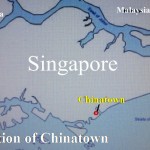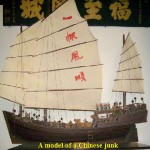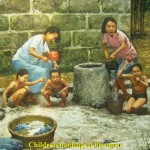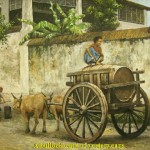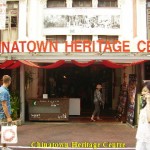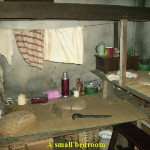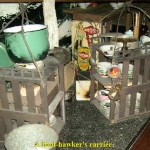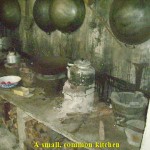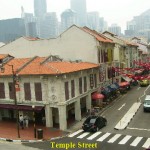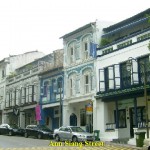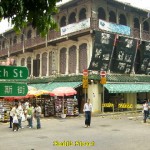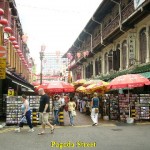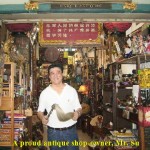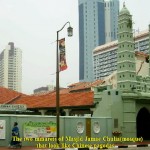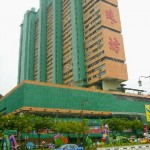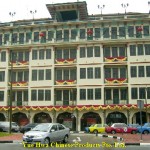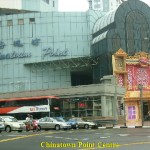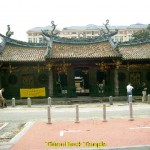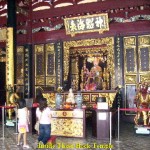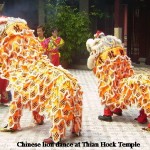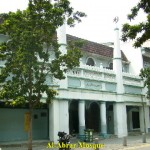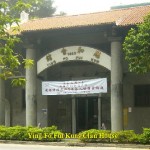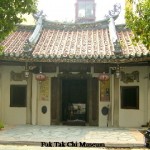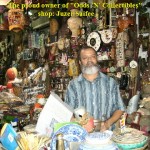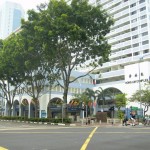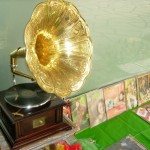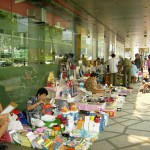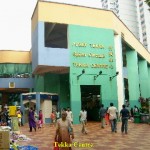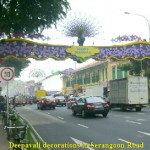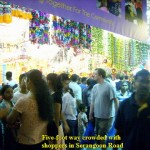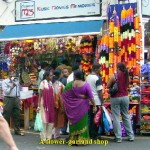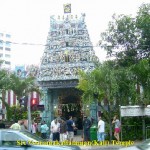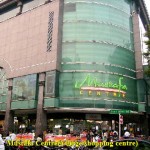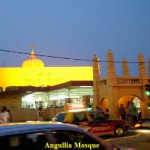Singapore Heritage Trail I
Filed under: Singapore Heritage Trail I (Chinatown & Little India)
Singapore Heritage Trail I
(Chinatown and Little India)
On a Singapore Heritage Trail
In 2006, I paid a visit to Singapore, a tiny nation, to learn about her rich history and diverse cultures. It took me a few days to visit four heritage places which are rich in histories and cultures. The four places are Chinatown, Little India, Kampong Glam-Malay Village and Civic District. Located in the south-east of Singapore Island, all these places are close to each other.
Below is what I have written about them and hope that most of the information given is still relevant:
1. Chinatown
Chinatown is located south of River Singapore. It was the first settlement for the Chinese immigrants. It was established around 1821 when the first junk which carried men from China arrived at Telok Ayer(Water Bay).
Before piped water supply was introduced in Chinatown, bullock carts were used to carry water from a nearby source called Ann Siang Hill to Chinatown. So the local Chinese called Chinatown “Niu Che Sui“, literally, it means “bullock-cart water”.
Chinatown Heritage Centre
To learn about the history of Chinatown and the stories of the Chinese immigrants, I went to the Chinatown Heritage Centre in Pagoda Street in Chinatown. It is a small museum of three restored pre-war shophouses.
Owing to poverty, famine, poor harvest of crops, drought, wars and corrupted rulers in China in the 1800’s, many Chinese migrated to the countries in South-east Asia, including Singapore. They hoped to make a fortune in the new countries and later return as a wealthy person.
The early immigrants came to Singapore in junks and later steamships. They had to endure a 7-week long and dangerous journey in vessels that were overcrowded and lacking amenities. Some unfortunate ones died in their journeys. Those who arrived at Singapore were uncertain of their future.
Many Chinese immigrants who came to Singapore realized that it was hard to make a living there. They worked as coolies, rickshaw-pullers, samsui women, food-vendors, tailors, clerks, shopkeepers, cooks, etc. Many succumbed to vices and had no money to go back to China. The hardworking ones became wealthy and made the island a progressive and prosperous country.
Squalid Living Conditions
In the olden days, many poor immigrants had to live in small cubicles in overcrowded shophouses. The latter had narrow corridors and small, dirty and black common kitchens. Looking at the squalid living conditions recreated in one of the shophouses at the Chinese Heritage Centre makes me feel sympathetic for the early immigrants.
In the past, there were small numbers of other races living in Chinatown, including Indians, Malays, Arabs and Japanese. Hence, it was a multi-ethnic and multi-cultural place.
Since 1900’s, many dilapidated pre-war shophouses in Chinatown were demolished. High-rise residential buildings and multi-storey complexes were built to replace them. The remaining old ones have been restored by the combined efforts of the owners and government. These quaint and well-restored buildings are now a tourists’ attraction in Chinatown.
It is worth visiting the Chinese Heritage Centre in Pagoda Street to learn about the Chinatown’s rich history and cultures.
Pagoda Street
It is intersting to know how Pagoda Street got its name. The Chinese saw the two minarets of a mosque, Masjid Jamae Chulia, at the end of the road that looked like Chinese pagodas. So they named the road Pagoda Street
While walking down Pagoda Street, I saw many shops and stalls in the street selling a myriad of things ranging from Asian antiques, Chinese paintings, souvenirs, clothes and cheap watches to digital cameras, cell-phones, MP3 and MP4 players. The street was crowded with both locals and tourists.
In the olden days, Pagoda Street was an infamous place for opium dens, gambling, prostitution, secret societies and slave trade. Many coolies squandered their hard-earned money on the vices, ending their dream of becoming rich and returning to their families in China. That street was the biggest residential area for coolies as the rental for a small cubicle in a shophouse was cheap.
There are a few large old shopping centres in Chinatown. Some of these are shown in the photos below:
Telok Ayer Street
This street is in Chinatown. It was once along a shoreline of the coast of Singapore. In 1821, the first Chinese junk, carrying immigrants from China, arrived in the bay. Then the immigrants set up their homes along Telok Ayer Street. Later immigrants from other countries, especially southern India, arrived there. That street then became an important commercial centre. In 1879, land was reclaimed from the bay, and roads, shophouses, clan association buildings, Chinese temples and a mosque(Al-Abrar Mosque) were built on it.
Thian Hock Temple
One of the oldest temples was built in Telok Ayer Street. It is known as Thian Hock Temple which houses a shrine to Ma Cho-Po (Mazu or Goddess of the Sea). The deity was brought from Fujian Province in China in 1840. According to a legend, Ma Cho-Po (960 A.D.-987 A.D.) was a daughter of a fisherman. One day, she sensed that her father and brother were in danger at sea during a storm. She quickly took a small boat and went to save them. But she was able to save her father only. When her whole village knew about her brave act, they worshipped her as a goddess of the sea, and the seafarers asked her for protection before sailing at the sea.
Al-Abrar Mosque
Originally, this mosque in Telak Ayer Street was a small thatched hut built by Indian Muslims in 1827. Later, it was rebuilt in 1850-1855. It is a simple-looking mosque which has an Indian Islamic theme.
Fuk Tak Chi Museum
Fuk Tak Chi (literally, it means “Temple of Virtue and Prosperity”) was also one of the oldest temples in Singapore. Located in Telok Ayer Street, it was a small temple built in 1824. Now, it is a small museum which displays some old exhibits, such as old Chinese storybooks, hawkers’ licence fee receipts, family portraits, antique furniture, weighing machines, iron that used charcoal, Chinese paintings and calligraphy, tea cups and pots and a model of Chinese junk. These things were donated by local residents.
Clan Association Buildings
Telok Ayer area has some social and meeting centres for the various Chinese clans and dialect groups. Many clan association buildings were built here to meet the needs of the immigrants like the social, cultural and political needs. An example of a clan association is Ying Fo Fui Kuns Clan House which was built in 1822. It is near Fuk Tak Chi Museum and caters for the Hakka members.
- Juzer Saifee, the proud owner of Odds ‘N’ Collectibles shop
There is a small shady garden, known as Telok Ayer Green, in Telok Ayer Street. It is next to Thian Hock Temple. in this garden, there are some interesting bronze sculptures depicting the immigrants’ activities in the past, as shown in the photos below:
An Antique Shop
While I was walking along Telok Ayer Street, I saw a shop at cluttered with lots of old things. Out of curiosity, I entered the shop. On closer look, I realized that most of the things on display were very common in every household in my childhood days, like clocks, cutlery, furniture, vases, stamps, money-notes, etc. These things can be considered as antigues now.
The shop known as Odds ‘N’ Collectibles, at 128, Telok Ayer Street, belongs to a bearded man, Juzer Saifee. He buys and sells secondhand things. He told me he had been in this business for over 10 years.
“Sook Ching”
In the city, right in front of Hong Lim Complex along Cross Road, I saw a notice-board that shocked me after reading its information. It says:
“This site was one of the temporary registration centres of the Japanese Military Police, the Kempeitai, for screening anti-Japanese Chinese.
On 18th. February 1942, three days after their capture of Singapore, Kempeitai launched a month-long purge of anti-Japanese elements in an operation named “Sook Ching”. All Chinese men between 18 and 50 years old, and in some cases women and children, were ordered to report to their temporary registration centres for interrogation and identification by the Kempeitai and their hooded informants. Those who failed the arbitrary screening were taken to outlying parts of Singapore and executed for alleged anti-Japanese activities. Tens of thousands were estimated to have lost their lives.
For those who were spared, the “Sook Ching” screening remains one of their worst memories of the Japanese Occupation.”
As I was reading the notice, I started to picture the unfortunate Chinese being taken away for the gruesome execution. It sent a shiver down my spine. The merciless conquerors had committed cruelty against humanity.
As I was walking further down Cross Road, I was pleasantly surprised to see a flea market in Far East Square where local people spread their secondhand goods on the floor for sale. They included old gramophone, records, story-books, magazines, antiques, clothes, Mao Tze Dong’s photos, letters, documents, watches, furniture, jewelleries, etc. This flea market is open only on Sundays.
Little India – Tekka Centre
To visit the Little India which is in the east of the Singapore River and learn about the Indian heritage, I took an MRT train to Little India Station. On arrival, I came out of the station and walked to Serangoon Road. On the way to the road, I came across a large green and yellow building, Tekka Centre, and decided to have a meal there.
It houses a wet market which meets the daily needs of the local people who live in HDB flats. Vegetables, fruits, fish and meats are easily available here. Next to the wet market is a hawker centre where one can savour a variety of local food. Above the hawker centre are several shops which sell inexpensive apparel, shoes, watches, etc.
After having a hearty meal with a bowl of “ais kacang” as dessert at the Tekka hawker centre, I continued my walk to Serangoon Road. As the Indian Festival of Lights or Deepavali was approaching, the road was already heavily decorated with arches, figures of phoenixes and coloured bulbs. When the sun set, the road was colourfully-lit and local Indians thronged the shops to buy the things they needed for their festival.
Serangoon Road
Serangoon Road is one of the oldest roads in Singapore. As the Serangoon area was a fertile plain, it attracted Indian immigrants to grow rice, gambier and coconut. Later, cattle-rearing and horse-racing became the main economic activities there. As more Indians settled at the place, it became an ethnic community known as “Little India”.
Old, quaint and beautifully restored shophouses line both sides of the busy road. Most of the shopkeepers here are Indians. They sell flower-garlands. jewelleries, silver and brassware, spices, saree fabrics, spicy vegetarian and banana leaf meal, electrical and electronic goods and more.
Along Serangoon Road are two popular places of worship as described below:
a. Sri Veeramakaliamman(Kali) Temple
Located along Serangoon Road. is the largest Indian temple in Singapore. It is known as Sri Veeramakaliamman Temple. It houses a black statue of Kali, the Goddess of Power, an incarnation of Lord Siva’s wife. She has many arms which hold weapons of destruction and is flanked by her sons, Ganesha and Murugan.
This temple was first built in 1855, and in 1908 it was expanded. The prominent feature of the temple is the tall entrance tower which has many colourful statuettes of deities and mythological animals. The main door of the temple has many bells. Hoping to have their requests granted, devotees will ring these bells first before entering the temple.
b. Angullia Mosque
Not far from the above-mentioned Hindu temple is a mosque, Anguilla Mosque, where the Indian Muslims pray. It is a simple looking mosque and was built in 1898 on a land belonging to the wealthy Anguillas, a family of Gujerati traders.
Mustafa Centre
As I was walking along Syed Alwi Road, I stopped at a well-known shopping complex, Mustafa Centre. It was opened in 1973. When I was in the building, I was awed to see every floor full of goods. A shopper will have no problem of getting anything he wants here and it is open 24 hours everyday.
(continued on Singapore Heritage Trail II)

